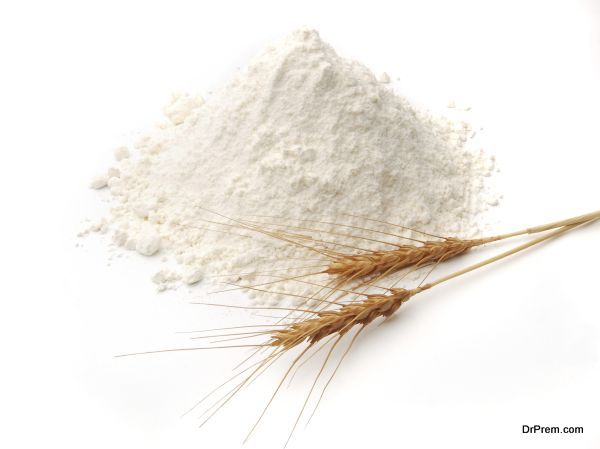Food allergies and food intolerance are two very different things. Although the symptoms are sometimes similar, a food allergy and intolerance are not the same. When someone suffers from a food allergy, the body’s immune system actually attacks the food and identifies it as an allergen. This means any time you consume this food, your body will project an allergic reaction. Some reactions are mild and cause skin irritations and itchiness or rash. Other reactions can be life threatening including the swelling and closing of a person’s throat or anaphylactic shock.
When you have a food intolerance, it means that you experience digestive trouble after eating a specific food. Food intolerances are not life threatening and are easily treated through a change in diet and avoiding certain foods. Some patients use functional medicine to treat their food intolerance. This article will break down what the most common food intolerances are and how the body reacts.
Gluten 
Nearly 20 million Americans suffer from a gluten intolerance, which comes in several forms. Gluten is found in wheat, barley, rye, and triticale. Some people suffer from celiac disease while others simply have a wheat allergy. Celiac disease is one of the most common reasons for gluten sensitivity and is considered an immune response and classified as an autoimmune disease.
When a person with celiac disease consumes gluten, the immune system attacks the small intestine, causing severe damage to a person’s digestive system. Symptoms include gas, diarrhoea, cramping, fatigue, heartburn, nausea, and fatigue.
But celiac disease isn’t the only cause of gluten intolerance. A wheat allergy can also develop as a gluten sensitivity and exhibit similar symptoms, although the body’s reaction is very different. When you have a wheat allergy, your body produces the same antibodies found in wheat. Because the symptoms are often the same, it’s hard to distinguish between these two conditions. For individuals suffering from any type of wheat intolerance, it’s best to eat only gluten-free foods. These include:
- Rice
- Beans
- Corn
- Tapioca
- Potatoes
- Flax
- Millet
Many packaged goods are also gluten-free, so check labels before purchasing.
Dairy 
A dairy intolerance, also known as being lactose intolerant, is another common food intolerance which has been around for decades. When someone has a dairy intolerance, it’s actually the body’s inability to properly digest the sugar found in some dairy products. This sugar is known as lactose. The human body contains an enzyme known as lactase, which helps the body break down and properly metabolism lactose and foods containing lactose. Your body has the most lactase as a young infant, when milk digestion is crucial for growth and development. But as you grow older, your body produces less lactase, making it more difficult for some people to break down lactose. This results in symptoms including gas, bloating, pain, and diarrhoea. A lactose intolerance may also occur following surgery, if a patient suffers a bacterial or viral infection in their gastrointestinal system.
Lactose is found in many foods, not just milk, yogurt, and cheese. The following products may contain lactose and could cause discomfort if you suffer from an intolerance.
- Ice cream/Sherbert
- Cakes/Cookies/Pies
- Pudding
- Whipped cream
- Caramel products
- Sour cream
- Cream cheese
But you can indulge in these items:
- Soymilk
- Lactose-free milk
- Rice milk
- Non-dairy creamers
Most people identify their dairy intolerance after suffering the common side effects. Experiment with different foods and how they make you feel. Do you suffer from gas pains and bloating after drinking whole milk? Try soy milk or rice milk and document if there’s a noticeable difference. Avoid ice cream and opt for a different dessert. Identifying this condition is often based on trial and error and treated by a change in diet.
Caffeine 
Sorry coffee drinkers, but there is such a thing as a caffeine intolerance. Caffeine is a staple in American society. A stimulant, caffeine offers drinkers a boost of energy and an alert feeling that helps them get through their day. Caffeine is found in coffee, some teas, sodas, and energy drinks. But as beneficial as this stimulant is for some, it can cause complications for others.
An aversion to caffeine can present itself in both an allergic and intolerant form. A caffeine intolerance can cause drinkers to experience a rapid heartbeat, anxiety, headaches, trouble sleeping, and an upset stomach. If you have an allergy to caffeine, which is extremely rare, the symptoms are slightly different. People allergic to caffeine may break out in hives or a rash, experience swelling of the lips or tongue, and itchy mouth, lips or tongue. These symptoms usually present themselves pretty quickly after a person consumes caffeine – within 60 minutes.
So, what causes an intolerance and an allergy to caffeine in the body? When you consume caffeine, it’s absorbed in your bloodstream through your stomach and effects how your organs function. This effect is different for everyone. Caffeine also affects the brain by blocking the chemical messages of fatigue and sleepiness from getting through. It also provides an adrenaline boost. This rush of adrenaline and energy can cause negative repercussions, like the ones mentioned above.
If this occurs, you likely have a caffeine intolerance. An allergic reaction to caffeine occurs for different reasons. When you consume caffeine, your body attacks it, like an invader. As your body works to push out these invaders (the caffeine) it can cause inflammation, leading to the other side effects mentioned (itching, swelling, and hives).
Other Food Intolerances 
These three are some of the most common food intolerances but they aren’t the only ones. Many foods contain additives like fructose and sulfites. These ingredients can cause reactions in people that present themselves as an intolerance.
Fructose is a sugar found in many foods including fruit, fruit juices, some vegetables, and honey. You’re likely familiar with high fructose corn syrup as well which is used to sweeten many processed foods and beverages. When someone has fructose intolerance, they have difficulty absorbing this ingredient, leading to increased levels in the intestines.
Sulfites are chemicals found in foods. Some sulfites are naturally produced while others are additives. Although rare, some people have sulfite sensitivity, causing upset stomach, hives, drop in blood pressure, trouble swallowing, and trouble breathing. These reactions can be mild or life-threatening. Foods that contain sulfites include dried fruits, wine, sauerkraut, lemon and lime juices, and molasses.
The best way to determine if you have any type of food intolerance is by monitoring how your body reacts to it. If you’re unsure if the discomfort you’re experiencing is due to a certain food, try keeping a food journal. This will help you document what food you eat and how you feel afterward, which can help identify food intolerances. And, as always, consult your physician if your symptoms worsen or drastically impact your life.
Article Submitted By Community Writer




